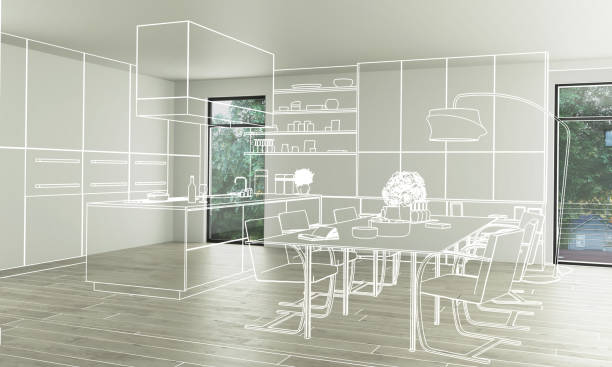Interior designing has come a long way since its inception, evolving from a mere decorative art to a full-fledged profession that impacts our daily lives in ways beyond aesthetics. As technology continues to advance and societal values shift, the future of interior design holds much promise and potential. In this blog, we’ll delve into the history and evolution of interior design, current trends, importance, recent innovations, and what is the future of interior design in India and globally.
What is Interior Designing?
Interior design is the art and science of enhancing the interior of a building to achieve a healthier and more aesthetically pleasing environment for the people using the space. Interior design also involves the planning and coordination of the furniture, fixtures, lighting, accessories, and other elements of the space. Interior design also reflects the culture, personality, and preferences of the clients and the users.
History and Evolution of Interior Design
Interior design has been a vital component of human civilization dating back to ancient cultures. From Egyptian tomb paintings depicting elaborate furnishings to Greek and Roman architectural elements influencing modern designs, the roots of interior design run deep. Throughout history, design has adapted to changing societal norms, cultural influences, and technological advancements.
In the early 20th century, interior design began to emerge as a distinct profession, with organizations like the American Institute of Interior Designers (AID) and the National Kitchen and Bath Association (NKBA) forming to establish standards and promote ethical practices. Today, interior designers are recognized for their expertise in creating functional, comfortable, and visually appealing spaces that enhance our quality of life.
Trends for the Future in Interior Designing- What is the Future of Interior Design?
How technology is changing the future of interior design is a fascinating topic that has gained significant attention in recent years. As we look towards the future, several trends are set to shape the interior design industry. Evolving alongside these trends is the transformative impact of technology, redefining the very essence of design processes and user experiences. The integration of cutting-edge technology is steering the future of interior design towards unprecedented innovation and limitless possibilities.
Sustainable and Green Design: With growing concerns about climate change, sustainable and eco-friendly design practices are becoming increasingly popular. This includes the use of natural materials, energy-efficient appliances, and renewable resources.
Smart Homes and IoT Integration: The rise of smart home technology and the Internet of Things (IoT) means that interior designers must now consider how to integrate devices, sensors, and automation systems into their designs.
Wellness and Healthy Spaces: Interior designers are placing greater emphasis on creating spaces that promote physical and mental wellbeing. This includes incorporating natural light, air purification systems, and calming color palettes.
Virtual Reality and Augmented Reality: VR and AR technologies allow designers to present clients with immersive, realistic simulations of their designs before implementation. This helps streamline the design process and reduces errors.
Customization and Personalization: Homeowners and businesses seek unique, tailored spaces that reflect their individuality. Interior designers must adapt to this trend by offering customized solutions and bespoke designs.
Importance of Interior Designing
Interior design plays a critical role in shaping our surroundings and influencing our daily lives. Here are some reasons why the future of interior design industry matters:
Enhancing Quality of Life: Interior designers create spaces that contribute to our physical and emotional wellbeing. By carefully selecting materials, colors, and lighting, they can improve air quality, reduce stress, and boost productivity.
Boosting Property Values: A well-designed space can significantly increase property values. Interior designers help homeowners and businesses make informed decisions about renovations, refurbishments, and new constructions.
Improving Functionality: Interior designers aim to create functional spaces that accommodate the needs of occupants. They ensure that storage, workflow, and circulation are optimized for maximum efficiency.
Cultural Significance: Interior design often reflects cultural and historical contexts. Designers draw inspiration from regional traditions, art, and architecture to create unique, culturally sensitive spaces.
Recent Innovations in Interior Designing
Technology has revolutionized the interior design industry, introducing novel materials, tools, and techniques. Some notable innovations include:
- 3D Printing: Allows designers to quickly produce custom prototypes, reducing production costs and timelines.
- Advanced Materials: New materials like nanotechnology-based surfaces, self-healing materials, and translucent concrete offer improved performance and aesthetics.
- Artificial Intelligence: AI algorithms assist designers in analyzing data, predicting trends, and generating design options, making the design process faster and more accurate.
- LED Lighting: LED lights offer energy efficiency, longer lifespans, and adjustable color temperatures, providing designers with greater flexibility in lighting design.
Conclusion
In conclusion, the future of interior design industry in India looks promising, with several trends and technologies expected to shape the profession in the coming years. The use of virtual and augmented reality, artificial intelligence, and sustainable design practices are likely to become more widespread, altering the way interior designers work and the services they offer.
Additionally, the growing demand for smart homes and commercial spaces, as well as the increasing focus on ergonomics and well-being, will continue to drive the industry forward. The future of interior design profession in India is also expected to be shaped by the rising influence of global design trends and the increasing participation of Indian designers in international design events. This will expose Indian designers to new ideas, techniques, and technologies, enabling them to create innovative and world-class designs.
Moreover, the future of interior designing in India is likely to be characterized by a growing emphasis on sustainability, with designers incorporating eco-friendly materials, energy-efficient appliances, and environmentally responsible practices into their designs. This not only benefits the environment but also provides a unique opportunity for Indian designers to showcase their skills and creativity on a global platform.
Overall, the future of interior design industry in India appears bright, with many exciting opportunities and challenges awaiting designers, manufacturers, and consumers alike. As technology continues to advance and consumer preferences evolve, the industry will undoubtedly continue to grow and adapt, shaping the future of interior design in India.




